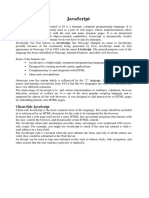0 ratings0% found this document useful (0 votes)
37 viewsJava
JavaScript is a scripting language used primarily for client-side web development to provide dynamic functionality on web pages. It is based on ECMAScript and uses a C-like syntax that was designed to look like Java, but be easier for non-programmers. While it has some similarities to Java like its object-oriented nature, JavaScript is dynamically typed and interpreted rather than statically typed and compiled like Java.
Uploaded by
AzamShCopyright
© Attribution Non-Commercial (BY-NC)
Available Formats
Download as RTF, PDF, TXT or read online on Scribd
0 ratings0% found this document useful (0 votes)
37 viewsJava
JavaScript is a scripting language used primarily for client-side web development to provide dynamic functionality on web pages. It is based on ECMAScript and uses a C-like syntax that was designed to look like Java, but be easier for non-programmers. While it has some similarities to Java like its object-oriented nature, JavaScript is dynamically typed and interpreted rather than statically typed and compiled like Java.
Uploaded by
AzamShCopyright
© Attribution Non-Commercial (BY-NC)
Available Formats
Download as RTF, PDF, TXT or read online on Scribd
You are on page 1/ 1
Java Scripting
Java is a scripting language used to enable programmatic access to objects within
other applications. It is primarily used in the form of client-side JavaScript for the
development of dynamic websites. JavaScript is a dialect of the ECMAScript standard
and is characterized as a dynamic, weakly typed, prototype-based language with first-
class functions. JavaScript was influenced by many languages and was designed to
look like Java, but to be easier for non-programmers to work with.
•Main article: JavaScript syntax
As of 2009, the latest version of the language is JavaScript
1.8.1. It is a superset of ECMAScript (ECMA-262) Edition 3.
Extensions to the language, including partial E4X (ECMA-357)
support and experimental features considered for inclusion into
future ECMAScript editions, are documented here.[13]
Sample code showcasing various JavaScript features
JavaScript and Java:
•A common misconception is that JavaScript is similar or
closely related to Java; this is not so. Both have a C-like
syntax, are object-oriented, are typically sandboxed and
are widely used in client-side Web applications, but the
similarities end there. Java has static typing; JavaScript's
typing is dynamic (meaning a variable can hold an object
of any type and cannot be restricted). Java is loaded from
compiled bytecode; JavaScript is loaded as human-
readable code. C is their last common ancestor language.
•Nonetheless, JavaScript was designed with Java's syntax and
standard library in mind. In particular, all Java keywords
are reserved in JavaScript, JavaScript's standard library
follows Java's naming conventions, and JavaScript's Math
and Date classes are based on those from Java 1.0.
You might also like
- Javascript (JS) Is A Lightweight Interpreted (Or: Eval For... in Object TostringNo ratings yetJavascript (JS) Is A Lightweight Interpreted (Or: Eval For... in Object Tostring1 page
- Java Script: Javascript Is An Interpreted ComputerNo ratings yetJava Script: Javascript Is An Interpreted Computer2 pages
- A PPT Persentation ON Java Programming Language BY Subhash Kumar 18BTCSE009No ratings yetA PPT Persentation ON Java Programming Language BY Subhash Kumar 18BTCSE00910 pages
- Introduction To Algorithms and JavaScript by Wilbert RibeiroNo ratings yetIntroduction To Algorithms and JavaScript by Wilbert Ribeiro5 pages
- Javascript: Javascript (JS) Is A Lightweight, Interpreted, orNo ratings yetJavascript: Javascript (JS) Is A Lightweight, Interpreted, or4 pages
- Cracking The Frontend Interview Part 4 JavaScriptNo ratings yetCracking The Frontend Interview Part 4 JavaScript7 pages
- Emscripten: An Llvm-To-Javascript Compiler: Alon ZakaiNo ratings yetEmscripten: An Llvm-To-Javascript Compiler: Alon Zakai12 pages
- Emscripten: An Llvm-To-Javascript Compiler: Alon ZakaiNo ratings yetEmscripten: An Llvm-To-Javascript Compiler: Alon Zakai12 pages
- ITEW2 WEEK 1 Introduction To JavaScript and JavaScript Fundamentals Part 1No ratings yetITEW2 WEEK 1 Introduction To JavaScript and JavaScript Fundamentals Part 112 pages
- Unit 1: Java Platform Overview: Take A High-Level Look at The Java Platform's ComponentsNo ratings yetUnit 1: Java Platform Overview: Take A High-Level Look at The Java Platform's Components3 pages
- Chapter 1: Getting Started With Java Language: RemarksNo ratings yetChapter 1: Getting Started With Java Language: Remarks1 page
- JAVA: Java Programming for beginners teaching you basic to advanced JAVA programming skills!From EverandJAVA: Java Programming for beginners teaching you basic to advanced JAVA programming skills!No ratings yet



























































